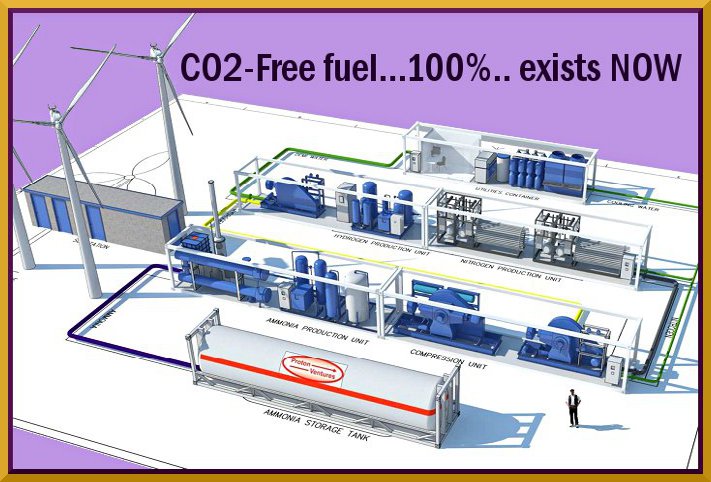also check out new CO2-free Blog HERE http://co2freefuelexistsnow.wordpress.com/
For nearly 100 years we have been forced to use petroleum, causing environmental devastation, runaway climate change and the agonizing deaths of countless millions of us through air pollution.
Now at last, with Climate Chaos becoming a daily reality, people are starting to ‘discover’ that a CO2, NOx and SOx FREE alternative has existed all along.
We are doing a micro campaign on this blog in favour of this CO2-free fuel. It’s a reformist solution, but one that’s available NOW
The criminal oil industry wants to close blogs like this, afraid prices would collapse if we started making NH3 car fuel.. locally with just wind, air and water
Please can you help? We need lots of free publicity and to persuade ‘respectable’ blogs, magazines, etc to write about it.
I’ve done some research and lots of posts and links you can view HERE (click below if you’re not already in this section)
check out new CO2-free Blog HERE http://co2freefuelexistsnow.wordpress.com/
NH3 is the closest thing to a perfect transportation fuel.
- NH3 is an ultra-clean, energy-dense alternative liquid fuel.
- Along with hydrogen, NH3 is the only fuel that does not produce any Greenhouse Gases (GHG) on combustion.
- NH3 combustion: 4NH3 + 3O2 2N2 + 6H2O (nitrogen and water vapor)
NH3 is Practical
- The first utilization of liquid NH3 as a fuel for motor-buses took place in Belgium during 1943. The motor-bus fleet logged 1,000’s of miles during WWII.
- 18% hydrogen by weight
- NH3 is a liquid fuel at ambient temperatures and moderate pressures (~125 psi)
- NH3 has 52% of the energy density of gasoline, and is over 50% more energy dense per gallon than cryogenic liquid hydrogen
- Can be used to drive fuel cells, and fuel internal combustion engines (ICE) and combustion turbines
- Converting gasoline and diesel ICEs to run on NH3 is relatively straightforward
- Can be economically and safely stored and delivered in large quantities
- A sustainable, carbon-free fuel for back-up and ‘peaker’ eletricity capacity generation
- Will help free us from dependence on imported oil – fossil fuel
Blueprint for ‘gasoline’ 100% free of CO2, NOx, SOx
I found it, thanks to Proton Ventures http ://www.protonchemie.com/NFUEL.html This is it, a process that is CO2 free, which makes a fuel that’s also CO2 free when burned. And it’s cheap and safer than petroleum. Free also of NOx and SOx pollution that KILLS millions of us Plus ALL combustion engines can be adapted to run on it. Q E D… This is a viable answer to cut CO2 emissions by 30% plus (transport) The rest is politics, capitalism, greed and criminal trashing of the planet.
Why NH3?
Our Mission
The mission of the NH3 Fuel Association is to promote the implementation of NH3 as an affordable, sustainable, carbon-free fuel for transportation and stationary power applications, thereby enhancing economic security, reducing fossil-fuel dependence, and helping save the environment.
Addiction to imported petroleum carries with it huge economic, environmental and security risks . The search for a domestically produced, economical and environmentally friendly fuel has led to one acceptable solution: anhydrous ammonia (NH3). Also known as «the other hydrogen» NH3 is the closest thing to a perfect transportation fuel.
- NH3 is an ultra-clean, energy-dense alternative liquid fuel.
- Along with hydrogen, NH3 is the only fuel that does not produce any Greenhouse Gases (GHG) on combustion.
- Hydrogen combustion: 2H2 + O2 2H2O (water vapor)
- NH3 combustion: 4NH3 + 3O2 2N2 + 6H2O (nitrogen and water vapor)
 NH3 is Practical
NH3 is Practical
- The first utilization of liquid NH3 as a fuel for motor-buses took place in Belgium during 1943. The motor-bus fleet logged 1,000’s of miles during WWII.

- 18% hydrogen by weight
- NH3 is a liquid fuel at ambient temperatures and moderate pressures (~125 psi)
- NH3 has 52% of the energy density of gasoline, and is over 50% more energy dense per gallon than cryogenic liquid hydrogen
- Can be used to drive fuel cells, and fuel internal combustion engines (ICE) and combustion turbines
- Converting gasoline and diesel ICEs to run on NH3 is relatively straightforward
- Can be economically and safely stored and delivered in large quantities
- A sustainable, carbon-free fuel for back-up and ‘peaker’ eletricity capacity generation
- Will help free us from dependence on imported oil – fossil fuel
NH3 is Available
- Current worldwide annual production is -130 million tons – primarily produced from natural gas and coal. China is the #1 producer at 30 million tons annually
- 20 million tons of NH3 and NH3-based fertilizers are consumed annually in the US as fertilizer (equivalent in energy to ~3.5 billion gallons of gasoline)
 Storage and delivery infrastructure of pipelines, barges, rail and truck already exists (3,000+ miles of pipeline in the US; retail outlets exist in practically every state, 800 outlets in Iowa alone)
Storage and delivery infrastructure of pipelines, barges, rail and truck already exists (3,000+ miles of pipeline in the US; retail outlets exist in practically every state, 800 outlets in Iowa alone)- Can be produced cleanly from coal and natural gas with carbon sequestration, and also from biomass, renewable energy sources and nuclear power, using nitrogen from the air
- Can be recovered from agricultural animal waste
- Naturally produced in legumes (via nitrogenase bacteria)
- Is an alternative fuel under the Energy Policy Act of 1992, allowing NH3 vehicles to qualify for fleet sale
 NH3 is Low Cost
NH3 is Low Cost
- Comparable to or lower in price than gasoline on an equal energy basis
- NH3 produced using renewable or nuclear source electricity will be stable in price and increasingly cheaper, per BTU, than fossil based fuels.
 NH3 is Environmentally Friendly and Safe
NH3 is Environmentally Friendly and Safe
- Zero carbon, no resultant Greenhouse Gases (GHG) on combustion
- NOx is easily neutralized (NH3 is used as the active chemical reactant in NOx reduction, and CO2 and SO2 capture)
- If released NH3 in an accident NH3 is very difficult to ignite, is lighter than air (dissipates upwards), and its odor alerts
- NH3 is not a Greenhouse Gas (GHG)
- Will not damage the ozone layer
 The X-15 rocket plane set speed and altitude records in the 1960s powered by NH3. Wind-generated electricity can be locally converted to NH3 for fertilizer and fuel, without expansion of the electricity transmission grid.
The X-15 rocket plane set speed and altitude records in the 1960s powered by NH3. Wind-generated electricity can be locally converted to NH3 for fertilizer and fuel, without expansion of the electricity transmission grid.
NH3 pipelines and storage terminals cross the agricultural midsection of the United States – an example of existing infrastructure that allows low cost, safe distribution of NH3. Storage is in refrigerated, liquid, above-ground steel tanks. NH3 is also transported by a broad array of existing rail, ship, and truck transports.
What if we do not need to wait for the hydrogen future of the year 2030? What if our hydrogen future is within our grasp right now?
It is.
The one pollution free, hydrogen-based renewable fuel we could begin using today on a large scale is anhydrous ammonia, one of the most commonly synthesized chemical compounds on the planet. Anhydrous ammonia is already used worldwide as fertilizer for its nitrogen content, and delivered by a well-established and safe infrastructure. Due to its hydrogen content, anhydrous ammonia (NH3) can be used in both gas and diesel internal combustion engines with minor modifications, can be used in direct ammonia fuel cells, and can provide hydrogen feedstock for standard hydrogen fuel cells…..
At the same time, improved technologies are coming on-line including lower cost electrolyzers and an approach called solid-state ammonia synthesis (SSAS), which makes ammonia without making hydrogen as an interim step.Even with the existing electrolyzer and Haber-Bosch process, ammonia is cost competitive with gasoline retailing at prices above $3 per gallon.
Ammonia has a long and successful history as a substitute for petroleum based fuels……
Of course, ammonia is not without its challenges. Ammonia is an inhalation hazard and must be handled with respect. But, the world ammonia industry produces and delivers 130 million tons a year with an exemplary safety record. About 20 million tons of ammonia is consumed in the U.S. annually, largely as fertilizer, and delivered by truck, rail, barge, and 3,000 miles of small-diameter, underground carbon steel pipeline in the U.S. agricultural heartland. Ammonia is not classified as a flammable liquid by the DOT, and does not have the fire and explosion hazard of gasoline, natural gas, propane, or hydrogen. Although hazardous when inhaled, it is lighter than air and disperses into the atmosphere when released, and without residual harmful effects. Ammonia is not a greenhouse gas, and does not attack the ozone layer.
For ammonia to be in wide use as a transportation fuel, design standards for on-board ammonia fuel tanks must be established as well as procedures for ammonia transfer from storage to vehicle tanks, however much of this work is already in place…..
The best features of ammonia are those it shares with hydrogen: it can be used both in internal combustion engines and in fuel cells, it produces no greenhouse gasses on combustion, and it can be produced from a wide variety of renewable energy resources…..
If hydrogen is the answer to the energy challenge of peak oil, then there is absolutely no reason to wait. The better hydrogen future is ready right now with proven

technology, from production and distribution to storage and engine modification. An aggressive program to use wind and solar power to generate this carbon-free fuel can create a sea of change in our energy policy. Ammonia fuel is not the one single answer to peak oil, because there is no single answer. But as an existing implementable strategy to cut greenhouse gases, reduce reliance on fossil fuels, and create new green collar jobs, ammonia is the stepping stone to the hydrogen future that up until now seemed decades away. ….
Larry Bruce is an international consultant in strategic planning and enterprise development and Marketing Director of StrandedWind.org. Joe McClintock is a physicist investigating alternative fuels. John Holbrook is Director of AmmPower LLC and Chairman of the Ammonia Fuel Network.
READ FULL ARTICLE HERE
http://www.thecuttingedgenews.com/index.php?article=799http://www.nh3fuelassociation.org/
also check out new CO2-free Blog HERE http://co2freefuelexistsnow.wordpress.com/
Related articles
- No CO2.. No Toxic Air.. NH3 Fuel.. (thefreeonline.wordpress.com)

